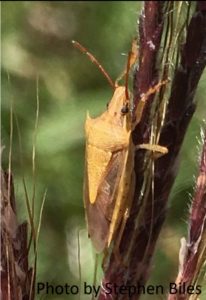We have reached the time of the growing season when Stink Bugs are the primary pest in most of the row crops on the Texas coast.
Sorghum maturity is from bloom to soft dough and will be susceptible to stink bugs until hard dough. Scout for stink bugs and headworms using a bucket to beat sorghum heads into until you have sampled 10. Then stop and count the stink bugs and headworms in the bucket. This should be done at 10-20 places per field and average the number of stink bugs and headworms per head. We have also found leaf-footed bugs in some sorghum fields.
The economic thresholds I use are calculated HERE.
- 0.5 to 1 Stink Bug per head
- 0.2 to 0.5 large worms (>0.5 inch) per head
- 1 to 2 medium worms (0.25-0.5 inch) per head
Cotton fields range from early bloom to cutout (5 nodes above white flower (NAWF)). Scout cotton for boll feeding bugs by opening 1-inch bolls and looking on the inside for evidence of feeding. This evidence of feeding will be warts on the inside of the boll wall or staining of the lint and seed. Treat fields when more than 20% of the 1-inch bolls have evidence of internal feeding or use the economic threshold based on the week of bloom.
Soybean maturity ranges from beginning pod development (R3) to full seed (R6). Beans are susceptible to stink bugs until the means are mature (R8). Sample fields using either a sweep net or a drop cloth. Fields should be treated when stink bug populations exceed 36 stink bugs per 100 sweeps or 1 per row foot. If Red Banded stink bugs are present, treat when populations exceed 16 red-banded stink bugs per 100 sweeps or 1 per 2 feet of row.
Upcoming Extension Meetings
Crop Tours (click for more info.)

